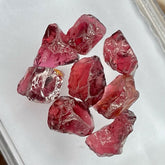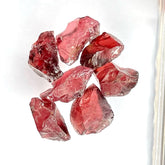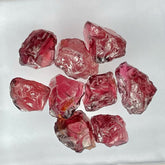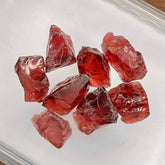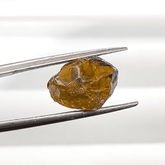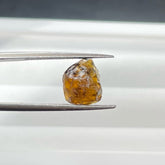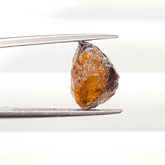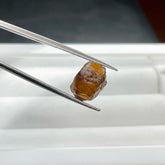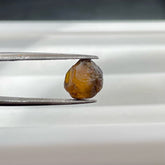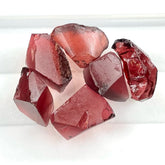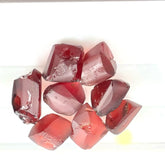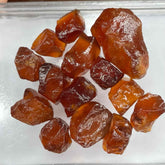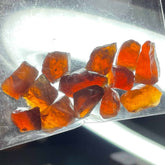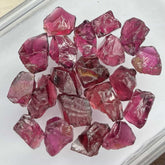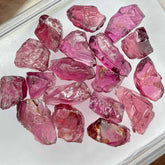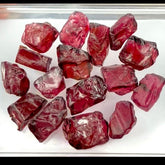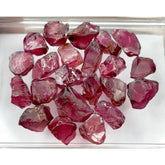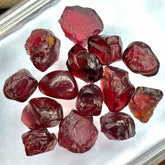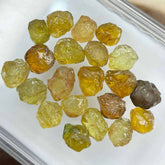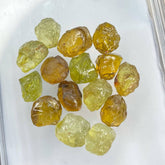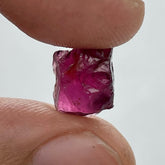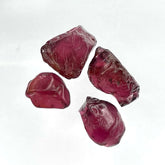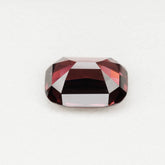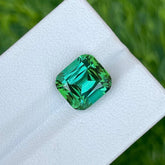Filter
67 results
30
- 10
- 15
- 20
- 25
- 30
- 50
Date, new to old
- Featured
- Best selling
- Alphabetically, A-Z
- Alphabetically, Z-A
- Price, low to high
- Price, high to low
- Date, old to new
- Date, new to old
Sort
Sort by:
- Featured
- Best selling
- Alphabetically, A-Z
- Alphabetically, Z-A
- Price, low to high
- Price, high to low
- Date, old to new
- Date, new to old
-
Deep Purplish Red Garnet Facet Rough Parcel
Deep Purplish Red Garnet Facet Rough Parcel Deep Purplish Red Garnet Facet Rough Parcel, available for sale at wholesale price, natural high quality, 65 carats, purplish red rough garnet gemstone from Tanzania. Product Information: Rough Gemstone Deep Purplish Red Garnet Facet Rough Parcel Weight...- $280.00
$286.00- $280.00
- Unit price
- / per
-
Clean Rhodolite Garnet Faceting Rough
Clean Rhodolite Garnet Faceting Rough Clean Rhodolite Garnet Faceting Rough, available for sale at wholesale price, natural high quality, 56.4 carats rough rhodolite garnet gemstone from Tanzania. Product Information: Rough Gemstone Clean Rhodolite Garnet Faceting Rough Weight 56.4 carats Average Weight 8 carats Biggest...- $246.00
- $246.00
- Unit price
- / per
-
Stunning Deep Carmine Garnet Facet Rough Parcel
Stunning Deep Carmine Garnet Facet Rough Parcel Stunning Deep Carmine Garnet Facet Rough Parcel, available for sale at wholesale price, natural high-quality 57.50 carats rough garnet gemstone from Tanzania. Product Information: Rough Gemstone Stunning Deep Carmine Garnet Facet Rough Parcel Weight 57.50 carats Average...- $253.00
- $253.00
- Unit price
- / per
-
Purplish Red Rhodolite Garnet Facet Rough
Purplish Red Rhodolite Garnet Facet Rough Purplish Red Rhodolite Garnet Facet Rough, available for sale at wholesale price, natural high-quality, 56 carats rough Rhodolite garnet gemstone from Tanzania. Product Information: Rough Gemstone Purplish Red Rhodolite Garnet Facet Rough Weight 56 carats Average Weight 8...- $246.00
- $246.00
- Unit price
- / per
-
Deep Carmine Garnet Facet Rough Parcel
Deep Carmine Garnet Facet Rough Parcel Deep Carmine Garnet Facet Rough Parcel, available for sale at wholesale price, natural high-quality, 70.50 carats rough garnet gemstone from Tanzania. Product Information: Rough Gemstone Deep Carmine Garnet Facet Rough Parcel Weight 70.50 carats Average Weight 7.83 carats...- $310.00
- $310.00
- Unit price
- / per
-
Milano Red Rhodolite Garnet Facet Rough
Milano Red Rhodolite Garnet Facet Rough Milano Red Rhodolite Garnet Facet Rough, available for sale at wholesale price, natural high-quality rough garnet gemstone from Tanzania. Product Information: Rough Gemstone Milano Red Rhodolite Garnet Facet Rough Weight 63.75 carats Average Weight 7.96 carats Biggest Piece...- $280.00
- $280.00
- Unit price
- / per
-
6.05 Carats Orange Brown Mali Garnet Facet Rough
Orange Brown Mali Garnet Facet Rough, available for sale at wholesale price, natural high-quality rough gemstone, garnet facet rough from Mali. Product Information: Rough Gemstone Orange Brown Mali Garnet Facet Rough Weight 6.05 carats Dimensions 11 x 8 x 7.8 mm Clarity VVS Origin...- $90.00
- $90.00
- Unit price
- / per
-
5.05 Carats Facet Rough Grossular Mali Garnet
Facet Rough Grossular Mali Garnet, available for sale at wholesale price, natural high-quality rough gemstone, eye clean, rough grossular garnet from Mali. Product Information: Rough Gemstone Facet Rough Grossular Mali Garnet Weight 5.05 carats Dimensions 9 x 8 x 7.5 mm Clarity Eye Clean...- $105.00
- $105.00
- Unit price
- / per
-
5.85 Carats Mali Garnet Facet Rough
Mali Garnet Facet Rough, available for sale at wholesale price, natural high-quality rough gemstone, eye clean, rough garnet from Mali. Product Information: Rough Gemstone Mali Garnet Facet Rough Weight 5.85 carats Dimensions 11 x 8 x 8 mm Clarity Eye Clean Origin Mali Treatment...- $120.00
- $120.00
- Unit price
- / per
-
6.25 carats Orange Grossular Garnet Facet Rough
Orange Grossular Garnet Facet Rough, available for sale, natural high-quality rough gemstone, eye clean, 6.25 carats rough garnet from Mali. Product Information: Rough Gemstone Orange Grossular Garnet Facet Rough Weight 6.25 carats Dimensions 11 x 8 x 7 mm Clarity Eye Clean Origin Mali...- $125.00
- $125.00
- Unit price
- / per
-
6.15 carats Grossular Mali Garnet Facet Rough
6.15 Grossular Mali Garnet Facet Rough, available for sale, natural high-quality rough gemstone, 6.15 carats rough garnet from Mali. Product Information: Rough Gemstone Grossular Mali Garnet Facet Rough Weight 6.15 carats Dimensions 10 x 8 x 7 mm Clarity Eye Clean Origin Mali Treatment...- $125.00
- $125.00
- Unit price
- / per
-
65.50 Carats Facet Rough Rhodolite Garnet Parcel
65.50 Carats Facet Rough Rhodolite Garnet Parcel is for sale at wholesale price from Tanzania. Product Information: Rough Gemstone Facet Rough Rhodolite Garnet Parcel Weight 65.50 carats Average Weight 10.91 carats Clarity Eye to Loupe Clean No of Pieces 06 Origin Tanzania Treatment None...- $285.00
$290.00- $285.00
- Unit price
- / per
-
90.80 Carats Orangy Red Rhodolite Garnet Facet Rough
90.80 Carats Orangy Red Rhodolite Garnet Facet Rough is for sale at wholesale price from Tanzania. Product Information: Rough Gemstone Orangy Red Rhodolite Garnet Facet Rough Weight 90.80 carats Average Weight 8.25 carats Clarity Eye to Loupe Clean No of Pieces 11 Origin Tanzania...- $360.00
- $360.00
- Unit price
- / per
-
93.25 Carats Rhodolite Garnet Facet Rough Parcel
93.25 Carats Rhodolite Garnet Facet Rough Parcel is for sale at wholesale price from Tanzania. Product Information: Rough Gemstone Rhodolite Garnet Facet Rough Parcel Weight 93.25 carats Average Weight 11.65 carats Clarity Eye to Loupe Clean No of Pieces 08 Origin Tanzania Treatment None...- $370.00
- $370.00
- Unit price
- / per
-
147 Carats Facet Rough Hessonite Garnet Parcel
147 Carats Facet Rough Hessonite Garnet Parcel is for sale at wholesale price from Africa. Product Information: Rough Gemstone Facet Rough Hessonite Garnet Parcel Weight 147 carats Average Weight 10.50 carats Clarity Cloudy No of Pieces 14 Origin Africa Treatment None Description: The name...- $95.00
- $95.00
- Unit price
- / per
-
136 carats Hessonite Garnet Facet Rough Parcel
136 carats Hessonite Garnet Facet Rough Parcel is for sale at wholesale price from Africa. Product Information: Rough Gemstone Hessonite Garnet Facet Rough Parcel Weight 136 carats Average Weight 10.46 carats Clarity Cloudy No of Pieces 13 Origin Africa Treatment None Description: The name...- $85.00
- $85.00
- Unit price
- / per
-
86.65 Carats Facet Rough Purple Garnet Parcel
86.65 Carats Facet Rough Purple Garnet Parcel is available for sale at wholesale price from Tanzania. Product Information: Rough Gemstone Facet Rough Purple Garnet Parcel Weight 86.65 carats Average Weight 4.33 carats Clarity Eye Clean / Better No of Pieces 20 Origin Tanzania Treatment...- $310.00
- $310.00
- Unit price
- / per
-
52.70 Carats Rhodolite Garnet Facet Rough Pieces
52.70 Carats Rhodolite Garnet Facet Rough Pieces are available for sale at wholesale price from Tanzania. Product Information: Rough Gemstone Rhodolite Garnet Facet Rough Pieces Weight 52.70 carats Average Weight 7.52 carats Clarity Eye Clean / Better No of Pieces 07 Origin Tanzania Treatment...- $230.00
- $230.00
- Unit price
- / per
-
75 carats Natural Purple Garnet Facet Rough
75 carats Natural Purple Garnet Facet Rough is available for sale at wholesale price from Tanzania. Product Information: Rough Gemstone Natural Purple Garnet Facet Rough Weight 75 carats Average Weight 3.75 carats No. of Pieces 20 Clarity Eye Clean / Better Origin Tanzania Treatment...- $240.00
- $240.00
- Unit price
- / per
-
88.30 Carats Purple Garnet Facet Rough Parcel
88.30 Carats Purple Garnet Facet Rough Parcel is available for sale at wholesale price from Tanzania. Product Information: Rough Gemstone Purple Garnet Facet Rough Parcel Weight 88.30 carats Average Weight 4.90 carats No. of Pieces 18 Clarity Eye Clean / Better Origin Tanzania Treatment...- $350.00
- $350.00
- Unit price
- / per
-
136 carats Vivid Burgundy Garnet Facet Rough Lot
136 carats Vivid Burgundy Garnet Facet Rough Lot which is available for sale at wholesale price from Tanzania. Product Information: Rough Gemstone Vivid Burgundy Garnet Facet Rough Lot Weight 136 carats Average Weight 8.5 carats No. of Pieces 16 Clarity Eye Clean / Better...- $490.00
- $490.00
- Unit price
- / per
-
157.50 Carats Purple Garnet Facet Rough Lot
157.50 Carats Purple Garnet Facet Rough Lot which is available for sale at wholesale price from Malaya. Product Information: Rough Gemstone Purple Garnet Facet Rough Lot Weight 157.50 carats Average Weight 7.15 carats No. of Pieces 22 Clarity Eye Clean / Better Origin Malaya...- $625.00
$650.00- $625.00
- Unit price
- / per
-
90.9 carats Red Garnet Facet Rough Parcel
90.9 carats Red Garnet Facet Rough Parcel which is available for sale at wholesale price from Tanzania. Product Information: Rough Gemstone Red Garnet Facet Rough Parcel Weight 90.9 carats Average Weight 6.50 carats No. of Pieces 14 Clarity Eye Clean / Better Origin Tanzania...- $365.00
$370.00- $365.00
- Unit price
- / per
-
Buy 78.45 Carats Grossular Mali Garnet Rough Parcel
Buy 78.45 Carats Grossular Mali Garnet Rough Parcel which is available for sale at wholesale price from Mali. Product Information: Rough Gemstone Grossular Mali Garnet Rough Parcel Weight 78.45 carats Average Size 3.75 carats No. of Pieces 21 Clarity Eye Clean to VVS Origin...- $655.00
- $655.00
- Unit price
- / per
-
Buy 50.60 Carats Facet Rough Grossular Garnet Pieces
Buy 50.60 Carats Facet Rough Grossular Garnet Pieces which are available for sale at wholesale price from Mali. Product Information: Rough Gemstone Facet Rough Grossular Garnet Pieces Weight 50.60 carats Average Size 5 carats No. of Pieces 10 Clarity Eye Clean to VVS Origin...- $505.00
$510.00- $505.00
- Unit price
- / per
-
Buy 69.30 Carats Grossular Garnet Facet Rough Lot
Buy 69.30 Carats Grossular Garnet Facet Rough Lot which is for sale at wholesale price from Mali. Product Information: Rough Gemstone Grossular Garnet Facet Rough Lot Weight 69.30 carats Average Size 4.62 carats No. of Pieces 15 Clarity Eye Clean to VVS Origin Mali...- $695.00
- $695.00
- Unit price
- / per
-
Buy 30.55 Carats Malaya Garnet Facet Rough
Buy 30.55 Carats Malaya Garnet Facet Rough which is for sale at wholesale price from Malaya. Product Information: Rough Gemstone Malaya Garnet Facet Rough Weight 30.55 carats Average Size 5 carats No. of Pieces 06 Clarity Eye Clean / Better Origin Malaya Treatment None...- $240.00
$255.00- $240.00
- Unit price
- / per
-
Buy 10.50 Carats Torch Red Garnet Facet Rough
Buy 10.50 Carats Torch Red Garnet Facet Rough which is for sale at wholesale price from Tanzania. Product Information: Rough Gemstone Torch Red Garnet Facet Rough Weight 10.50 carats Dimensions 12 x 9 x 8.5 mm Clarity Eye Clean Origin Tanzania Treatment None Description:...- $85.00
- $85.00
- Unit price
- / per
-
Buy 7.60 Carats Magenta Red Garnet Facet Rough
Buy 7.60 Carats Magenta Red Garnet Facet Rough which is for sale at wholesale price from Tanzania. Product Information: Rough Gemstone Magenta Red Garnet Facet Rough Weight 7.60 carats Dimensions 12.5 x 8 x 7.5 mm Clarity Eye Clean Origin Tanzania Treatment None Description:...- $65.00
- $65.00
- Unit price
- / per
-
Buy 29.20 Carats Facet Rough Solid Pink Garnet Lot
Buy 29.20 Carats Facet Rough Solid Pink Garnet Lot which is for sale at wholesale price from Tanzania. Product Information: Rough Gemstone Facet Rough Solid Pink Garnet Lot Weight 29.20 carats Average Size 7.3 carats Clarity Eye Clean No. Of Pieces 4 Origin Tanzania...- $230.00
- $230.00
- Unit price
- / per
